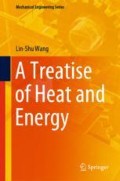Abstract
Clausius generalized the mathematical expression of Carnot’s principle obtained by Kelvin, and in 1865, introduced the concept of entropy and formulated the entropy principle. With the concept of entropy and the idea of the entropy principle , a definition of heat can be given, as well as mathematical formalism on equilibrium thermodynamics was formulated for organizing empirical data of thermodynamic properties. The establishment of the entropy principle signaled the beginning of a new era—in which, thermodynamics, which had originated as a branch of engineering knowledge, separated into two distinctive streams. The new science stream was manifested in the mathematical formalism on equilibrium thermodynamics. It is noted that the entropy principle , rather than the energy principle , is the true universal principle.
Access this chapter
Tax calculation will be finalised at checkout
Purchases are for personal use only
Notes
- 1.
The Carnot machine operates as a Carnot heat engine during some microcycles and as a Carnot heat pump during the other microcycles.
- 2.
Take the example of the system of a cooking vessel, which is brought to a very high temperature in two ways of cooking. Electric resistive coil cooking is an example of heat -exchange process carrying both energy flow and its associated entropy flow; electric induction cooking is an example of (electromagnetic field energy) work -exchange process carrying no entropy flow—with heat generation entropy -production process taking place inside cooking vessel. Entropy gain in the former case results from entropy in-flow across the boundary of the vessel and in the latter case from entropy production within the boundary.
- 3.
The engineering connection is particularly strong in North British: “North British group of scientists and engineers, including James Joule, James Clerk Maxwell, William and James Thomson, Fleeming Jenkin, and P. G. Tait, developed energy physics to solve practical problems encountered by Scottish shipbuilders and marine engineers” noted Smith [14].
References
Planck M (1969) Treatise on Thermodynamics, 3rd edition. Dover, New York
Jaynes ET (1984) The evolution of Carnot’s principle. EMBO Workshop on Maximum-Entropy Methods (Orsay, France, April 24–28, 1984. Reprinted in Ercksen & Smith [1988], 1:267-282)
Smith C, Wise MN (1989) Energy and Empire: A Biographical Study of Lord Kelvin. Cambridge Univ Press
Clausius R (1865;1867) On Different Forms of the Fundamental Equations of the Mechanical Theory of Heat and Their Convenience for Application. Presented to Zuricher naturforschende Gesellschaft on April 24, 1865. Published in Abhandlungen uber die mechanische Warmetheories 2:1–44 (1867)
Fermi E (1956) Thermodynamics. Dover (p. 48)
Wang LS (2007) The nature of spontaneity-driven processes. International J of Ecodynamics 2: 231–244
Gibbs JW (1961) The Scientific Papers of J. W. Gibbs, Vol. 1: Thermodynamics. Dover (p. 354)
Uffink J (2001) Bluff your way in the Second Law of Thermodynamics. Stud Hist Phil Sci Part B: 2001 Studies in Hist and Philo of Modern Physics 32(No.2):305–395
Planck M (1887) Uber das Princip der Vermehrung der Entropie, in 3 parts. Ann. D. Phys. 30:562–582; 31:189-203; 32:462-503
Newburgh R, Leff H S (2011) The Mayer-Joule Principle: The foundation of the first law of thermodynamics. The Physics Teacher 49(November):484–487
Brookes D, Horton G, Van Heuvelen A, Etkina E (2005) Concerning scientific discourse about heat. AIP Conference Proceedings 790:149–152.
Romer RH (2001) Heat is not a noun. Am J Phys 69(2):107–109
Daub EE (1970) Entropy and dissipation. Historical Studies in the Physical Sciences 2:321–354
Smith C (1991) Lord Kelvin: Scientist of energy. Supercond Sci Technol 4:502–506
Callen HB (1st edition, 1960; 2nd edition, 1985) Thermodynamics and an Introduction to Thermostatistics. Wiley, New York
Born M (1949) Natural Philosophy of Cause and Chance. Oxford Univ Press (p. 38)
Carathéodory C (1909) Untersuchungen uber die Grundlagen der Thermodynamik. Math. Ann. 67: 355–386. A translated text “Investigation into the foundations of thermodynamics” is collected in J. Kestin, The Second Law of Thermodynamics (Dowden, Hutchinson and Ross, 1976). Pages referred to this reference in-text are that of the translated text.
Landsberg PT (1961) Thermodynamics. Interscience, New York (p. 94)
Gislason EA, Craig NC (2005) Cementing the foundations of thermodynamics: comparison of system-based and surroundings-based definitions of work and heat. J. Chem. Thermodynamics 37:954–966
Author information
Authors and Affiliations
Corresponding author
Rights and permissions
Copyright information
© 2020 Springer Nature Switzerland AG
About this chapter
Cite this chapter
Wang, LS. (2020). Entropy and the Entropy Principle. In: A Treatise of Heat and Energy. Mechanical Engineering Series. Springer, Cham. https://doi.org/10.1007/978-3-030-05746-6_5
Download citation
DOI: https://doi.org/10.1007/978-3-030-05746-6_5
Published:
Publisher Name: Springer, Cham
Print ISBN: 978-3-030-05745-9
Online ISBN: 978-3-030-05746-6
eBook Packages: EngineeringEngineering (R0)

